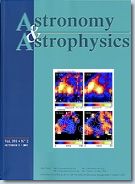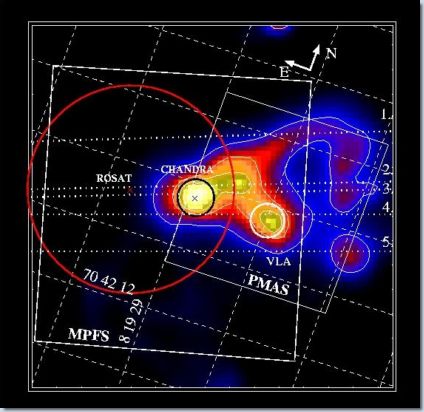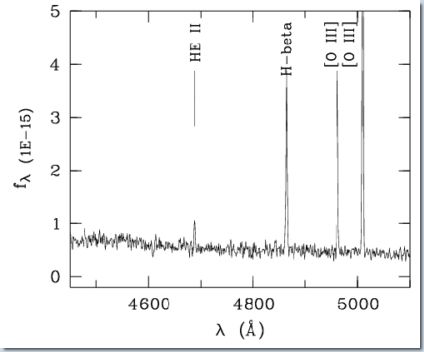 |
|
Astronomy & Astrophysics titles:
Integral field spectroscopy of the ultraluminous X-ray source Holmberg II X-1
|
The Potsdam Multi-Aperture Spectrophotometer (PMAS) observes ultraluminous X-ray source
The two main classes of discrete galactic X-ray sources, X-ray binaries and supernova remnants (SNR), have been known and relatively well understood for decades. A third class of galactic X-ray sources was detected with Einstein thanks to its high spatial resolution and its large collecting area (Fabbiano 1989). These objects have become known as Ultraluminous X-ray sources (ULX) and they have 0.5-10 keV luminosities of 1039-1041 erg/s, generally higher than black hole binaries such as Cyg X-1 and SMC X-1, but lower than that of active galactic nuclei (AGN). Assuming Eddington luminosities, this corresponds to accretion onto black holes of between ten and several hundred solar masses suggesting intermediate-mass black holes (IMBHs; see Colbert & Mushotzky 1999, Miller & Colbert 2004 for a review). ULX are not located in the dynamical center of their host galaxies and thus they are not caused by sub-Eddington accretion onto a central AGN-type super-massive black hole. The identification of the optical counterparts of ULX is essential to determine the nature of these objects. The number of optically identified ULX is still limited, only a small number of reliable optical counterparts are known to date.
Here we present optical integral field observations of the H II region containing the ultraluminous X-ray source Holmberg II X-1. We confirm the existence of an X-ray ionized nebula as the counterpart of the source owing to the detection of an extended He II (4686 A) region 21 x 47 pc) at the Chandra ACIS-S position. An extended blue object with a size of 11 x 14 pc is coincident with the X-ray/He II (4686 A) region, which could indicate that it is either a young stellar complex or a cluster. We find a complex velocity dispersion at the position of the ULX. In addition, there is a radial velocity variation in the X-ray ionized region found in the He II emission of +-50 km/s on spatial scales of 2-3". We believe that the putative black hole not only ionizes the surrounding HII gas, but also perturbs it dynamically (via jets or the accretion disk wind). The XMM-Newton spectrum of HoII X-1 is best fitted with an absorbed power law in addition to either a thermal thick plasma or a thermal thin plasma or a multi-colour disk black body (MCD). In all cases, the thermal component shows a relatively low temperature (kT~0.14-0.22 keV). The existence of an X-ray ionized nebula coincident with the ULX and the soft X-ray component with a cool accretion disk favours the interpretation as an intermediate-mass black hole (IMBH). However, the complex velocity behaviour at the position of the ULX indicates a dynamical influence of the black hole on the local HII gas.
Dr. Ingo Lehmann, MPE Garching
Veröffentlichungen
I. Lehmann, T. Becker, S. Fabrika, M. Roth, T. Miyaji, V. Afanasiev, O. Sholukhova, S. F. Sánchez, J. Greiner, G. Hasinger, E. Costantini, A. Surkov and A. Burenkov:
"Integral field spectroscopy of the ultraluminous X-ray source Holmberg II X-1"
Astronomy & Astrophysics 431 (Nr. 3), p. 847
M.M. Roth, A. Kelz, T. Fechner, T. Hahn, S.-M. Bauer, T. Becker, P. Böhm, L. Christensen, F. Dionies, J. Paschke, E. Popow, D. Wolter, J. Schmoll, U. Laux, W. Altmann:
"PMAS, the Potsdam Multi-Aperture Spectrophotometer. I. Design, Manufacture, and Performance" Publ. Astr. Soc. Pacific, accepted for publication
|
|

CFHT archival H-alpha image of the HoII X-1 region. The MPFS FOV and the PMAS mosaic FOV are superposed. The small black and the large red circles give the 90% confidence circles of the Chandra ACIS-S and the ROSAT HRI positions, respectively. The small white circle shows the location of the radio peak at 6, 20, and 90 cm wavelengths (see Tongue & Westpfahl 1995). Long-slit positions (1-5) are indicated with dotted lines.

The co-added PMAS spectrum at the X-ray position (see Figure above) clearly shows an He II (4686) emission line.
|
|


 last change 2006 October 16, R. Arlt
last change 2006 October 16, R. Arlt


